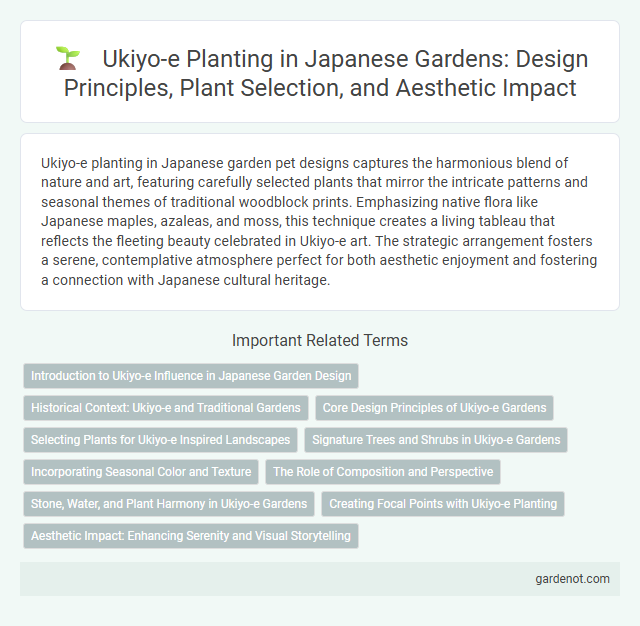Ukiyo-e planting in Japanese garden pet designs captures the harmonious blend of nature and art, featuring carefully selected plants that mirror the intricate patterns and seasonal themes of traditional woodblock prints. Emphasizing native flora like Japanese maples, azaleas, and moss, this technique creates a living tableau that reflects the fleeting beauty celebrated in Ukiyo-e art. The strategic arrangement fosters a serene, contemplative atmosphere perfect for both aesthetic enjoyment and fostering a connection with Japanese cultural heritage.
Introduction to Ukiyo-e Influence in Japanese Garden Design
Ukiyo-e, the traditional Japanese woodblock printing, significantly influences Japanese garden design by inspiring the arrangement of plants to emulate scenes depicted in prints. Gardeners incorporate elements such as flowing water, seasonal blossoms, and asymmetrical compositions reflecting Ukiyo-e's emphasis on natural landscapes and transient beauty. This artistic integration fosters a harmonious environment that evokes the serene and poetic qualities central to Ukiyo-e aesthetics.
Historical Context: Ukiyo-e and Traditional Gardens
Ukiyo-e, a celebrated genre of Japanese woodblock prints from the Edo period (1603-1868), vividly captures traditional garden scenes showcasing seasonal plants such as cherry blossoms, maples, and irises. These prints reflect the cultural significance of garden design in Edo society, emphasizing harmony with nature and the aesthetic principles of wabi-sabi and mono no aware. Traditional Japanese gardens depicted in Ukiyo-e often highlight carefully arranged planting compositions that symbolize transient beauty and spiritual contemplation.
Core Design Principles of Ukiyo-e Gardens
Ukiyo-e gardens prioritize asymmetry and naturalistic elements to reflect the transient beauty of nature, emphasizing seasonal changes through carefully selected plants like moss, pine, and cherry blossoms. The use of layered planting techniques creates depth and perspective, while water features symbolize purity and continuity within the design. Pathways and viewing points are strategically arranged to evoke a sense of flow and contemplation, embodying the core aesthetic principles of wabi-sabi and mono no aware.
Selecting Plants for Ukiyo-e Inspired Landscapes
Selecting plants for Ukiyo-e inspired landscapes involves choosing species that reflect traditional Japanese aesthetics and seasonal changes depicted in Ukiyo-e prints. Iconic plants such as cherry blossoms (sakura), Japanese maples (Acer palmatum), irises (Iris ensata), and mosses create authentic textures and vibrant color contrasts. Emphasizing natural forms and harmony, these selections enhance the garden's poetic and visual connection to classical Japanese art.
Signature Trees and Shrubs in Ukiyo-e Gardens
Ukiyo-e gardens prominently feature signature trees and shrubs such as Japanese maple (Acer palmatum) and azalea (Rhododendron spp.), which are celebrated for their seasonal color changes and intricate foliage. These plants are carefully arranged to reflect the aesthetic principles of ukiyo-e art, emphasizing harmony, asymmetry, and natural beauty. The use of these iconic species enhances the garden's visual narrative, mirroring the delicate brushstrokes and vibrant palettes found in traditional ukiyo-e prints.
Incorporating Seasonal Color and Texture
Ukiyo-e planting in Japanese gardens emphasizes the dynamic interplay of seasonal color and texture through carefully selected flora such as azaleas, maples, and cherry blossoms, which transform the garden's appearance throughout the year. The deliberate layering of contrasting textures--from delicate moss carpets to rugged stone arrangements--enhances the visual depth and harmony typical of Ukiyo-e aesthetics. This approach creates a living canvas that reflects the transient beauty and subtle shifts of nature, central to Japanese garden design philosophy.
The Role of Composition and Perspective
Ukiyo-e planting in Japanese gardens emphasizes composition and perspective, creating visually balanced scenes that mimic traditional woodblock prints. Strategic placement of plants directs the viewer's gaze, utilizing asymmetry and layered depth to evoke a harmonious interplay between nature and art. This approach enhances spatial perception and immerses visitors in a dynamic, carefully framed environment.
Stone, Water, and Plant Harmony in Ukiyo-e Gardens
Ukiyo-e gardens emphasize a harmonious blend of stone, water, and plant elements, reflecting the Edo period's aesthetic principles. Stones are strategically placed to mimic natural mountainous landscapes, while water features such as ponds and streams create a serene, flowing environment that complements vibrant seasonal plants. This balance embodies the Ukiyo-e philosophy of capturing transient beauty through nature's tranquil and dynamic interplay.
Creating Focal Points with Ukiyo-e Planting
Ukiyo-e planting in Japanese gardens emphasizes creating focal points by strategically arranging plants that mimic the layered compositions found in traditional ukiyo-e woodblock prints. The use of vibrant seasonal flowers, such as azaleas and cherry blossoms, alongside sculptural evergreens like pine trees, draws the eye to specific garden areas. This technique enhances visual depth and narrative, guiding visitors through a harmonious interplay of natural elements and artistic expression.
Aesthetic Impact: Enhancing Serenity and Visual Storytelling
Ukiyo-e planting in Japanese gardens enhances serenity by creating layered compositions that mimic traditional woodblock prints, emphasizing harmony between natural elements and human artistry. Carefully arranged flowering plants and foliage evoke seasonal transitions and poetic narratives, inviting contemplative reflection and deepening the garden's visual storytelling. This approach transforms the garden into a living ukiyo-e scene, where aesthetics and nature converge to elevate sensory and emotional experiences.
Ukiyo-e planting Infographic

 gardenot.com
gardenot.com